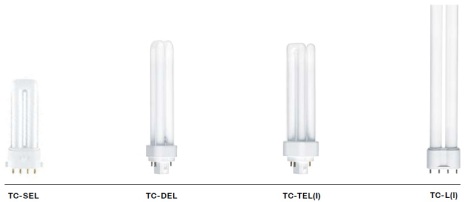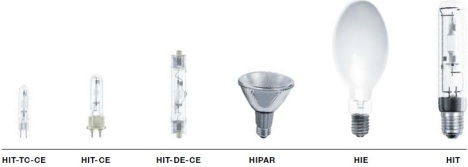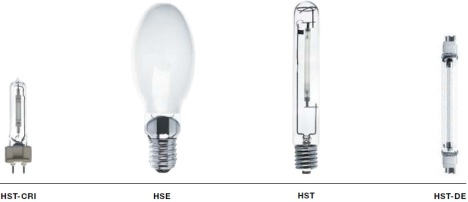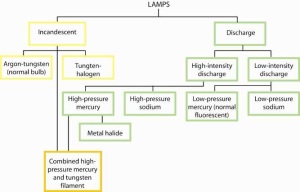Source:
[1] Faranda et al. Design and Technology for Efficient Lighting (29), Paths to Sustainable Energy.
[2] Zumtobel Lighting GmbH, 2013. The Lighting Handbook, 4th edition.

# Incandescent
Characteristics:
* Very low in efficacy (10–15 lm/W), lifetime (1000 h) & investment (high running costs);
* Dimmable;
* Need reflector for concentrated light beams;
* Very-high CRI, but low CCT.Applications:
* For general, local, ambient & spot lighting;
* Not suitable for high-levels lighting necessary.
# Halogen (low-voltage)
Characteristics:
* Very-small, capable of producing highly direct light beams;
* Some losses in transformer;
* Low-to-mid in efficacy (15–33 lm/W) & lifespans (2000 to 6000 h);
* Very-high CRI, but low CCT (slightly higher than incandescent).Applications: Highly suitable for spotlighting.
# Halogen (high-voltage)
Characteristics:
* Slightly higher efficacies than incandescent (15–25 lm/W) with lifetime of 2000 to 6000 h;
* Very-high CRI, but low CCT (slightly higher than incandescent).Applications: Suitable for spotlighting or illuminating large areas (flood lighting).

# Linear Fluorescent
Characteristics:
* Mid-to-high efficacy 60–100 lm/W (when used electronic ballasts), with lifetime of 7000 to 20,000 h;
* High-to-very-high CRI, with broad-range of CCT available.Applications:
* Highly suitable for general indoor illumination (especially to provide economic)
* Widely used for all low- & mid-bay lighting;
* Not suitable for spot lighting.

# Compact Fluorescent (ballast-integrated)
Characteristics:
* Directly interchangeable with incandescent lamps >> greater energy efficiency (35–80 lm/W) & much longer life expectancy (5000 to 15000 h);
* Not dimmable;
* Also available with reflector;
* High CRI & broad-range of CCT available.Applications: For almost all areas (where incandescent are used) >> general, local & spot lighting.
# Compact Fluorescent with modular/external ballasts
Characteristics:
* Slightly higher efficacy than CFLs (60–80 lm/W), with longer lifetime of 10,000 to 20,000 h;
* Dimmable when used specially-designed electronic ballasts.
* High CRI & broad-range of CCT available.Applications: Alternative to incandescent (more efficient).
# Induction
Characteristics:
* Very-long lifetime of 30,000 to 100,000 h & mid-to-high efficacy of 55–80 lm/W;
* High CRI & wide-range of CCT available.Applications: Relatively high-first-costs, but most-economic when used in inaccessible areas with high maintenance costs (such as tunnel lighting).

# Metal-halide
Characteristics:
* Mid- to high-efficacy (47–105 lm/W), with lifetime of 6000 to 20,000 h;
* Warm-up time of few minutes;
* Difficult for dimming & sometimes suffers from poor lumen-maintenance (whenever long operating-hours applied);
* High CRI & broad-range of CCT available.Applications:
* Suitable for mid- and high-bay indoor & outdoor lighting;
* Most-commonly used for industrial & street lighting.
# Ceramic metal-halide
Characteristics:
* High-efficacy (67–104 lm/W), with lifetime of
6000 to 15000 h;
* Warm-up time of few minutes;
* Difficult for dimming;
* High CRI & low- to mid-range CCT available.Applications: Suitable for mid & high-bay indoor display lighting (as substitute for halogen) and also provide street & architectural lighting.

# High-pressure sodium
Characteristics:
* High- to very-high efficacy (70–120 lm/W), with lifetime of 5000 to 30000 h;
* Poor-to-moderate CRI & relatively long warming-up periods;
* Low CCTs (orange-yellow hued light).Applications: Economic street & industrial lighting (where high CRI is not required).
# Super high-pressure sodium
Characteristics:
* Start-up time in few minutes;
* Not dimmable;
* Reasonable efficacy;
* Color-change might be possible at the end of useful/life.Applications: Suitable for lighting objects (shop window displays) or as general down-lighting in high-ceilinged rooms.
# Low-pressure sodium
Characteristics:
* Very-high efficacy 120–200 lm/W, with lifetime of 10,000 to 16000 h;
* Monochromatic light (no colour rendering) & very-low CCT.Applications: Low-cost outdoor lighting for applications where color rendering is not required.
# High-pressure mercury vapor
Characteristics:
* Low- to mid-efficacy 23–60lm/W, with lifetime of 6000 to 28000 h;
* Poor-to-moderate CRI & CCT, and relatively long warming-up periods.Applications:
* Mostly-used for street, security & industrial lighting;
* Low-first-costs but uneconomic over the life-cycle (compared to equivalent alternatives).
# Self-ballasted mercury vapor (non-blended)
Characteristics:
* Very-low to low-efficacy 14–29 lm/W, with lifetime of 6000–12000 h;
* Poor-to-moderate CRI & CCT and relatively long warm-up periods.Applications:
* Mostly-used for street, security & industrial lighting in non-OECD countries;
* Very-low first-costs but highly uneconomic over the life-cycle (compared to equivalent alternatives).
Filed under: Alam Takambang Jadi Guru | Leave a comment »


